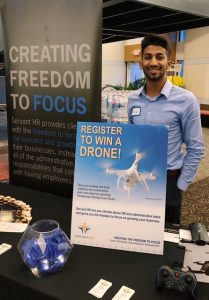
by Mike Yoder | Business Resource, General, HR News, Human Resources, Legal Compliance
A new National Labor Relations Board (NLRB) decision has drawn a blurrier line between employers and independent contractors. Returning to pre-Obama-era policies, the NLRB is now more likely to acknowledge independent contractor relationships.
A wide array of federal, state and local laws govern the relationship between employers and their employees. But often these laws do not apply to those classified as independent contractors.
The distinction between the two is critical, but hazy, as each law has a slightly different way of discerning independent contractors from employees. Courts and agencies add complication as well through differing interpretations of those laws, along with frequently changing standards according to appointed political party.
Back and Forth
Last year the California Supreme Court broadened the definition of “employee” for wage order claims. Obama-era guidance restricted an employer’s ability to classify workers as independent contractors. Now under President Trump, federal agencies are swinging back the other way.
According to Ryan Funk of Faegre Baker Daniels, the new NLRB decision returns to how it viewed independent contractors before Obama-era restrictions. Funk writes, “The main difference between the new test and the Obama-era one is how the agency looks at whether workers have ‘entrepreneurial opportunity.’”
Action vs. Opportunity
The Obama-era decision gave weight only to actual entrepreneurial activity (and even then, only when looking at just one part of a multi-factor test.) This narrow view makes the chance of meeting criteria significantly slim.
The new NLRB decision re-establishes the value of entrepreneurial activity. The principle of “opportunity for entrepreneurial activity” is used to evaluate the overall effect of each of the ten factors in a common-law analysis of an independent contractor relationship.
The decision is employer friendly, as it frees up employers to classify independent contractors and drop the host of governing laws.
Boiling It Down
While employers are freed up through the new decision, the line is still blurry. Those looking for a clear distinction between employee and independent contractor are in for a letdown. According to Funk, “Any legal test with ten factors is bound to boil down to a case-by-case approach.”
Even tests and their factors can vary case-by-case. Over the last thirty years the IRS has used an old revenue ruling twenty-point test, the tax court has used a seven-point test, and the IRS has espoused a three-pronged “control test.” Confusion is certainly understandable.
Therefore, independent contractor relationships should be re-analyzed in light of the new NLRB approach. Based on potential IRS involvement, it’s also important to note that the NLRB is just one voice in a crowd of agencies, so employers should stay up to date as independent contractor tests continue to evolve.

by Mike Yoder | Business Resource, HR News, HR Tips, Human Resources, Technology
Since the agricultural revolution of the 18th century, the productivity and efficiency of technology has instilled fear of employment displacement. Everything from surgical automation to grocery store self-checkout has people wondering: Am I going to lose my job to a computer?
The concern is legitimate. According to the 2017 Global Future of Work Survey report from Willis Towers Watson, business leaders expect 17 percent of work will be automated by 2020. While some industries (i.e. manufacturing, military, etc.) have been highly automated for years, other sectors such as retail, finance, banking and insurance are currently reeling from increases in automation. Restaurant kiosks, ATM machines and even automated financial planning platforms are being offered in place of human talent.
Technology’s power to transform economic sectors is nothing new, and its influence is only speeding up. So what does automation mean for HR — a department namely for humans?
HR is not exempt from the impact of automation. According to the Society of Human Resource Management, “Software bots and sophisticated algorithms are making it much easier for recruiters to source and screen job candidates, a function formerly performed solely by very human HR employees.”
Technology provides a more user-driven employee experience and most commonly automates tasks that are tedious and time consuming. We at Servant HR have experienced this on a small scale through the implementation of electronic onboarding. Automation has lessened the paperwork shuffle and provides employees with forms they can fill out on their own laptop, on their own time.
Automation advances undoubtedly improve customer service and eliminate human error. It’s definitely good… but isn’t that kind of bad? For the ones who get paid for the paper shuffle?
It sounds like it, but it’s widely argued that humans still retain an edge. As smart as computers are, the human body itself is a flexible and adaptable work platform. Human workers see the details, weigh implicit factors and can make complex decisions in unique situations. While rote work can become more efficient, according to a KPMG study, jobs that involve networking, project management, sales, conflict resolution, hospitality, creativity and any level of social intelligence are insulated.
But insulated doesn’t mean isolated. The automation revolution is a revolution for a reason—it’s everywhere. Rather than viewing automation as the enemy, Lisa Buckingham, a brand officer at Lincoln Financial Group, encourages today’s businesses to “provide a blend of digital and human services.”
This analysis is based off of companies like Amazon and Lyft, who were born digital. These companies continue to raise consumer expectations across all industries for simple, transparent solutions. Even the most creative and human-centered jobs must embrace the efficiency and simplicity of technology.
Oxford University program directors, Michael Osborne and Carl Frey, have conducted extensive research on the future of employment. Their work also reveals that tasks requiring relationship building and an understanding of human needs in social situations are best-suited for humans.
We think so too. At Servant HR, relationship is our priority. Our people-centered approach to businesses makes our team of experts an irreplaceable asset to our clients, despite the imminence of automation.
Automation is not the enemy. Done right, automation frees up human workers to provide more hospitality, one-on-one interaction and detail-oriented customer service.
And service is what we’re all about.
To learn more about what our personal PEO can do for your business, contact us today!

by Mike Yoder | Business Resource, Culture, Hiring, HR News, HR Tips, Human Resources, Legal Compliance
When it comes to legal situations around social media and the workplace, the best defense is a good offense. You may not be asking these exact questions today, but someday you might. Keep reading to learn how to avoid legal traps as an employer, and how to formulate a stronger social media policy as an HR professional.
Q: “My employee is making comments about me on his/her personal Facebook account. What can I do?”
A: Perhaps nothing has emboldened people more than the rise of social media. Comments one wouldn’t dare make in person can now be expressed quickly and frequently behind the perceived safety of the internet.
But as inappropriate or insulting as a post may be, employers do not always have the right to take action against an employee for social media behavior. The National Labor Relations Act enforces the right of employees to engage in “protected concerted activity.” This law allows employees, with or without a union, to act together to improve their pay and working conditions.
Q: “What exactly qualifies as protected concerted activity?”
A: According to the National Labor Relations Board, an employee simply griping about their job is not concerted activity. Whatever an employee says or posts on social media must have “some relation to group action, or seek to initiate, induce or prepare for group action or bring a group complaint to the attention of management.”
However, the NLRB decides what actions deserve protection, and because every situation is different, the law is intentionally vague. Sometimes comments made on social media are interpreted as protected concerted activity because they are supported by other coworkers or simply directed at management.
In one case, an employee of a New York catering company was fired for profane Facebook comments directed at his boss and his boss’s family. Still, the NLRB found this employee protected, since the comments were made during a work break, expressed the employee’s concern about management and ended with an all caps call to join the union. The NLRB ordered reinstatement and back pay for the employee.
Less extreme examples of concerted activity include talking with coworkers about wages and benefits, circulating a petition for better hours, participating in refusal to work in unsafe conditions or joining with coworkers to address issues directly with an employer, government agency or media outlet.
The law does not protect spreading maliciously false information, or bashing an employer’s products or services without linking back to a labor controversy. However, the still-vague terms have caught many employers in legal traps.
Q: “So employers can never terminate employees for online behavior?”
A: Not exactly. Off duty conduct laws vary state to state, but employers do have the right to regulate online activity. For example, an employer can discipline employees for online behavior during work hours. However, they must be consistent in enforcing this policy. Discipline must be enforced for all online activity during work hours, not just when negative comments about the company are made.
Employers must also take action when an employee’s online actions place the employer at legal risk. Examples of this include betraying confidential information, violating rules about company product endorsements or harassing a coworker.
Employers should intervene when an employee acts disloyally online as well. Complaining about a manager or pay rate on Twitter isn’t considered disloyal, but if an employee claims online that the hospital where they work is unsafe, this is considered disloyal. However, if employees address legitimate safety concerns with an employer or government agency, this activity is protected.
Q: “What other ways can I prevent legal situations around social media in the workplace?”
A: Employers must welcome feedback. Many attacks on social media happen out of pent up frustration. If frustration can be expressed early on when everyone is still rational, the extreme cases can be avoided.
Consistent communication about social media policy is also essential. Along with routine education and training, it is important for company handbooks to have compliant social media policy in order for interceding action to take place fairly and consistently. Any employer action in response to employee behavior on social media must be in line with previous action and easily traceable to a clear handbook policy.
However, even “airtight” social media guidelines leave employers susceptible to accusations and lawsuits. Focusing on prevention is first, but staying up to date on labor relations laws is a close second.
Still have questions? We have answers and experience. Contact us today to see how Servant HR can serve your administrative and consulting needs.

by Mike Yoder | Business Strategy, Culture, Employee Benefits, Hiring, HR Tips, Human Resources
For some employers, “onboarding” is defined as that first paperwork meeting with a new hire — shaking hands, filling out tax forms and practicing signatures. For others, onboarding is simply any learning that takes place from day one on the job. Either way, both interpretations of onboarding are necessary parts of the hiring process, as employees work to acclimate to a new employer.
Even after you’ve sealed the deal, there is still a small gap of critical time between job acceptance and an employee’s first day. Usually a few weeks are given for employees to transition out of their current job and take a breath before their new one begins. But a lot can happen during that gap. Job offers are often used to bargain in other interviews or leverage a promotion with a current employer.
Some employers combat this risk by starting the onboarding process earlier. “If we can get them in the door faster and have them start completing insurance forms, they’ll be less likely to quit!” But research shows retention comes less from eager paperwork meetings and more from relationship and exceptional hospitality.
Guarding the Gap
Creative initiatives to welcome and engage new hires, from the time of offer acceptance to day one, are called preboarding. While ultimately beneficial for employers and a company’s bottom line, preboarding is most effective when genuinely focused on the employee.
Whether it’s that first meeting or the first few weeks of work, employees begin learning everything about their new employer during onboarding.
Preboarding offers an extra-mile opportunity for the employer to learn about the employee.
Taking time and honest interest in a new hire demonstrates the value a company places on its people. This helps new hires make the jump to a new workplace and feel at home faster (while inadvertently encouraging their best work).
Thinking Ahead
Attention to hospitality details may seem like a waste of time, but ignoring preboarding can prove costly. Consistent communication with new hires before their first day prevents ambivalence and makes employees less likely to continue communication with other potential employers. Lack of engagement before starting work allows new hires to feel that nothing is yet final and continue pursuing other offers.
Employers may use up some time on the front end, but preboarding also saves time on day one. Since a new employee has already become familiar with the team, culture and business operations in the weeks after acceptance, day one can be a work day rather than a day of introductions and tours.
So how is it done? Is it really just muffin baskets and welcome emails? Sometimes!
To put it a simpler way, preboarding has been called, “onboarding that’s more fun.”
Different ideas work better for different companies, but these small things can help new hires feel welcomed, valued and excited to stick around:
- Before an employee’s first day, schedule a tour followed by a lunch with immediate team members or their managers. This helps the employee to feel more confident on their first day instead of walking in blind.
- Send the employee a questionnaire after acceptance to outline things they like and dislike. When figuring out where to go/what to cater during a welcome lunch, the employee’s favorite place can be chosen without putting them on the spot. This questionnaire can be used throughout an employee’s time, as a way to intentionally thank them for good work. (Employers can also post employee questionnaires for everyone to see, fostering intentional relationships between coworkers.)
- Pay attention in interviews and follow up with specifics. If a new hire mentions their family in the interview, send a gift basket including treats for their kids. If they just moved to the area, gift them with favorite local goods and a list of restaurant recommendations from their coworkers.
- Keep checking in. Consistent emailing shows an employer is available. Sending a schedule of the first week, creating their email account and telling them when their desk is set up lets a new hire know you’re anticipating their arrival and keeps them in the loop.
- Some companies offer “show up bonuses” on an employee’s first day or at the end of their first month. Of course this isn’t feasible for every company, but this bold gesture is an unexpected way to show appreciation.
- Follow through. Hospitality attempts can seem insincere if new employees are left to fend for themselves after day one. In the initial learning stage at a new job, consistent check-ins are necessary to ensure confident acclimation specific to each new hire. This care and attention will not go unnoticed and can help ensure best fit for both employees and employer.
You may not be able to give your employees a million bucks, but you can make them feel like it! These small gestures help to guard that gap of critical time, and keep your employees excited about their new position with you.
Want to spend less time with the HR hassle and more time with your people? We want that for you too. Contact us today and see how Servant HR can give you the freedom to focus on what’s most important.

by Mike Yoder | General, HR News, HR Tips, Human Resources
Few things are more contagious than recognition, encouragement and gratitude. Creating an office culture of thankfulness is not seasonal work, but a year-round initiative sparked most often by leaders. The humility demonstrated by employers, managers and HR professionals in acknowledging and appreciating others can spread quickly through an organization. Simple “thank-yous” have the power to transform a workplace.
As we approach thanksgiving, we thought we would practice this gratitude with you, as well as share a few Servant HR updates! We have so much to be thankful for this year.
1. Our people
In the midst of our office remodel this week, our team still gathered together for our Monday prayer meeting. We shared personal and work-related prayer requests in a circle on the floor of our empty new conference room. We are grateful for our dedicated team members and their flexibility in transition. Each person brings a variety of skills and personality traits and we appreciate their hard work.

Our temporary team meeting spot, since no shortage of furniture can keep our team from Monday mornings together.

Our small but mighty team manages payroll, benefits administration and all things HR for clients across the Midwest.
2. Our clients
Lately we have been given opportunities to see our clients in action and we are so thankful for the organizations we serve. Edge Mentoring’s EDGE|X conference reinforced our values about servant leadership and provided us with unique networking opportunities. Hosting a booth at Truth at Work’s Transformation conference also introduced us to new people and ideas on leadership and humility. We are proud of the work our clients do and feel blessed to partner with so many different missions and organizations.

Our Truth at Work conference booth featured details about Servant HR, information about our upcoming network series and a drawing to win a free drone.
3. Our space
For our friends and clients a few states away, you may wonder where we actually work! While we serve clients in over twenty-five states, our team of eleven works out of an office complex in Fishers, Indiana. Now, after several months of prayer and planning (and a few demo days!) we are operating out of a new office that better fits our growing team

Demolition of our old space continues as our team works on the other side of the wall.

The new expansion provides more office space, several conference rooms, a break room and a waiting lounge.
The new space is an expansion of our old one into a vacant neighboring office and God has been so faithful to provide this smooth transition. We are especially thankful for Avera Commercial LLC and their quick, diligent work through the construction process. Adrian Sodrel and his team have been a huge blessing, working many late nights and early mornings to keep our workplace clean and functional.

Adrian and his team hard at work in one our new office spaces.

Avera Commercial workers rip up old carpet with cheerful smiles.
We have been richly blessed and still have much to be thankful for. So, are you infected yet? We hope our gratitude is contagious and inspires you to spend time intentionally thanking your family, your boss, your friends, your managers and coworkers this season.
Wishing you a Happy Thanksgiving from all of us at Servant HR!

by Mike Yoder | Business Strategy, Culture, Hiring, HR Tips, Human Resources
Halloween is just around the corner, and yet… few things spook employees more than those looming, end-of-year reviews.
A recent survey of 1,000 full-time employees found that one in four have called in sick because they were anxious to face an appraisal. Almost 75% felt “in the dark” about how their managers viewed their performance leading up to review, and 62% felt blindsided afterward. In the aftermath, 15% have cursed, 15% have cried and 28% have started looking for other jobs.
If employees are ghosting, impending performance reviews should spook employers as well. But the review process doesn’t have to be so scary! Here are three tips for making performance reviews more of a treat than a trick:
1. Start Early
Feedback should be established as routine upon hire. Performance reviews don’t have to be once a year, doomsday meetings—they can be monthly or weekly touchpoints that start as early as an employee’s first day. Early reviews are a chance to develop trust and relationship between manager and employee and to get employees comfortable with talking about their performance.
Consistent communication and feedback from the start helps employees understand the purpose of appraisals and develop confidence in the review process.
Employers can also provide new hires with their performance review format so there are no surprises. This gives employers leverage and prevents employees from getting blindsided.
2. Converse
The first tip makes this second tip a lot easier. If relationship is not established, it’s common for managers in performance reviews to talk… a lot. However, a performance review is most effective as a discussion, not a lecture. Lectures can make employees feel like they’re just being yelled at, but intentional, back-and-forth conversation allows employees to experience trust and respect from their manager. Managers encourage this kind of conversation simply by asking questions. Good performance reviews offer space for employees to consider their goals, preferences, set-backs, achievements and failures. Rather than listing off highs and lows, employees are best motivated by analyzing individual potential and growth. A review should prioritize gaining insight into the performance of both employee and employer, which means feedback about management should be prompted as well.
3. Be Positive
Healthy organizations don’t sweep issues under rugs. Problems are dealt with right away and any necessary critique or discipline happens in real time—not months later at a performance review. Honest confrontation and consistent communication should be practiced daily in order to ensure positive performance reviews. Spending the majority of time on the positive aspects of an employee’s performance is almost always more effective than spending the majority of time on the negative. Don’t neglect areas that need improvement, but no employee’s performance is completely negative—make sure that is not being reflected in the review. Acknowledge failures by asking questions, exploring options and landing conversations on upbeats. People are best motivated when specific actions are recognized and appreciated. Providing direct encouragement and ways for improvement keeps performance reviews constructive and cultivates healthy work relationships.
Trust and relationship is at the core of effective reviewing. If done early and often, performance reviews don’t have to be daunting, vague meetings that hang over the holidays. Asking good questions and seeking the best for employees develops respect—enabling managers to humbly accept feedback and constructively analyze ways for employee improvement.
Need ideas for review formats? Still feeling a little spooked? We’re here to help. Contact us today!













